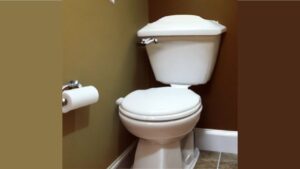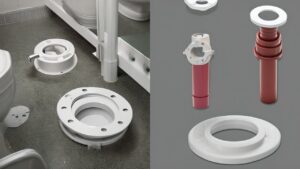This post contains affiliate links, meaning I may earn a commission at no extra cost to you if you make a purchase. As an Amazon Associate, I earn from qualifying purchases
A toilet flange is an important component of your toilet plumbing system that connects the toilet bowl to the drainpipe.
However, the flange can develop leaks over time, causing water damage and unpleasant odors in your bathroom.
Various factors, such as a worn-out wax ring or a damaged flange, can cause these leaks.
In this guide, we will explore the most common causes of toilet flange leaks and provide step-by-step instructions on how to fix them.
So you can restore your toilet to its proper working condition.
The Toilet Flange
Before we understand the common causes of toilet flange leaks, let’s first understand what a toilet flange is.
A toilet flange is a circular fitting that connects the toilet to the drainpipe.
It is usually made of PVC or cast iron and is attached to the floor with screws.
The flange sits on top of the drainpipe, creating a tight seal that prevents water and sewage from leaking.
Common Symptoms of Leaking Toilet Flange
Several symptoms may indicate a leaking toilet flange.
If you notice those symptoms, you can be certain that your toilet flange has encountered some problems.
Some of the most common symptoms include:
- Water on the floor around the toilet’s base: If you notice water on the floor around the base, it could be a sign that the flange is leaking.
- Difficulty flushing the toilet: If the toilet is difficult to flush or does not flush properly, it could be a sign that the flange is clogged or damaged.
- A constantly running toilet: If the flange is leaking, it can cause the toilet to constantly run as water continues to flow into the tank to replace the leaking water.
- A strong odor: If the flange is leaking, it can allow sewage gases to escape and create a strong, unpleasant odor in the bathroom.
- A wobbly toilet: If the flange is leaking, it can cause the toilet to become loose and wobbly, as the bolts may not be able to create a secure connection with the flange.
- Visible damage to the flange: If you can see visible damage, such as cracks or breaks, it could be a sign that the flange is leaking.
If you notice these symptoms, addressing the issue immediately is important.
It will help you to avoid further damage to the toilet and prevent water from leaking into your home and costly repairs.
Common Causes of Toilet Flange Leaks
Here are some common causes of leaking toilet flanges
Loose or Damaged Bolts
The toilet flange holds the toilet in place and is secure to the floor with bolts.
Over time, these bolts can become loose due to normal wear and tear. They can also become damaged by shifting or settling foundations.
If you notice your toilet wiggling or rocking, it could be a sign that the bolts are loose.
You can try tightening the bolts with a wrench to fix this issue. If the bolts become damaged, you’ll need to replace them.
Warped or Broken Flange
The Flange damage can cause leaks because; it cannot properly seal the toilet to the floor.
To determine if the flange is the cause of the leak, you can visually inspect it for cracks or warping.
If the flange is damaged, it must be repaired or replaced.
Gaps Between the Flange and Toilet Base
If there is space between the two, water can escape and cause a leak.
This can be caused by a too-low flange or a toilet base not properly seated.
To fix this issue, you can use a toilet shim to fill in the gap or adjust the height of the flange.
Clogged or Blocked Drainpipe
If the drainpipe is clogged, water backs up and causes a leak.
Signs of a clogged drainpipe include a slow-flushing toilet or water backing up in the shower or sink.
You can use a plunger or a chemical drain cleaner to unclog the drain pipe.
Worn or Damaged Seals
Worn or damaged seals can cause leaks.
The seals around the toilet’s base can become worn or damaged over time, allowing water to escape.
To determine if the seals cause the leak, inspect them for visible cracks or a loose toilet base.
If the seals are damaged, they will need to be replaced.
Fix the Leaking Toilet Flange
To fix a leaking toilet flange, you will need to:
- Shut off the water supply to the toilet by clockwise turning the valve behind the toilet.
- Flush the toilet to remove as much water as possible from the tank and bowl.
- Remove the toilet by loosening the bolts holding it to the flange, and lifting it off.
- Inspect the flange for damage or debris. If the flange is damaged, it may need to be replaced. If there is debris in the drain pipe, you must clear it out.
- Clean the area around the flange and make sure it is dry.
- Replace any damaged or rusted bolts with new ones.
- Re-install the toilet by placing it back onto the flange and tightening the bolts to secure it.
- Turn the water supply back on and test the toilet to ensure it no longer leaks.
Comparison of Toilet Flange Leak Causes and Fixes
| Cause | Fix |
|---|---|
| Broken Flange | Replace the Flange |
| Worn Wax Ring | Replace the Wax Ring |
| Loose Bolts | Tighten the Bolts |
| Cracked Toilet | Replace the Toilet |
Key Takeaway
Toilet flange leaks can be a major headache, but they can be fixed with the right tools and knowledge.
The most common causes of toilet flange leaks are a broken flange, worn wax ring, loose bolts, and a cracked toilet.
If you experience any of these issues, you can fix them by replacing the flange or wax ring, tightening the bolts, or replacing the toilet.
If you are unsure how to fix the problem, it’s best to call a professional plumber to avoid further damage.
Remember, regular maintenance of your toilet and its components can help prevent leaks and other issues from arising.
Check the toilet flange periodically for signs of wear and tear, and address any problems as soon as they arise to avoid costly repairs in the future.
Conclusion
Understanding the common causes of toilet flange leaks and how to fix them is essential for preventing costly repairs.
If you suspect a toilet flange leak, it is best to address it promptly to avoid further damage.
If you’re unsure how to fix the issue, it’s always best to consult a professional plumber.
Who has the tools and expertise to quickly diagnose and repair toilet flange leaks, saving you time and hassle?



